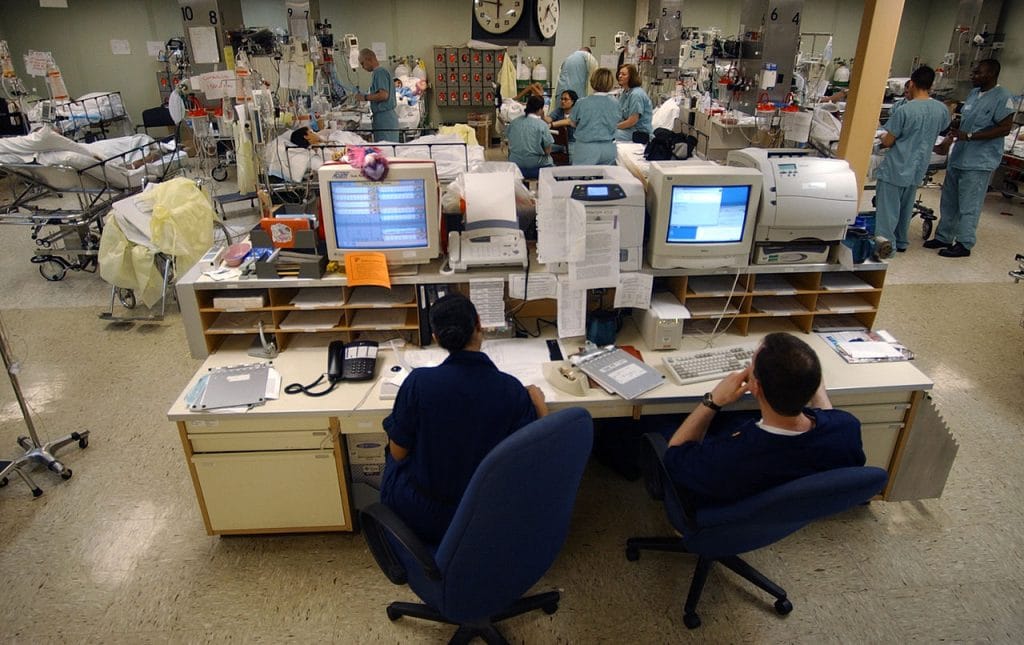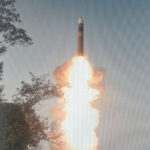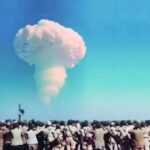How many intensive care beds will a nuclear weapon explosion require?
By Tom Sauer, Ramesh Thakur | April 28, 2020

A novel coronavirus emerged in Wuhan, China late last year, hopping in one way or another from other animals to humans. Initially the rest of the world thought this outbreak was a local problem and then was shocked at the brutality of the lockdown that the Chinese authorities clamped on Wuhan to quarantine the infection cluster. Despite China’s efforts at containment, soon the virus rode the highways and byways of globalization to quickly circle the world. Other countries realized their hospital systems could be overwhelmed unless they drastically slowed the surge of new infections. No country had the number of beds in its intensive care units (ICUs) to manage patient loads under worst-case scenarios of letting this new coronavirus spread through the community to acquire herd immunity.
To those of us whose primary professional interest lies in nuclear weapons and the dangers they pose, the coronavirus pandemic is a striking validation of the Humanitarian Initiative, which took off 10 years ago with three core propositions: First, no country individually has the capacity to cope with the humanitarian consequences of a nuclear war, and the international system doesn’t have it collectively, either. Second, it is therefore in the interests of all humanity that nuclear weapons never be used again, under any circumstances. And finally: The only guarantee of non-use is the complete elimination of nuclear weapons. These precepts were the powerful impetus behind the Nuclear Weapons Ban Treaty that 122 states at the United Nations adopted in July 2017.
The pandemic speaks to the truth of the first proposition about the power of the bomb. The near-universal response to the panic created by COVID-19 leads us to the conclusion that the number of ICU beds needed to deal with a disaster should become a new norm, and a new way to judge when radical action is needed to respond to a global threat. So what other types of global catastrophes could call for more hospital infrastructure and personnel than is now available? The bomb is one obvious answer. Are the number of ICU beds sufficient to respond to a disaster caused by the explosion of one nuclear weapon or, in a war, many? No, they are not sufficient. Not even close.
A serious threat assessment consists of estimating the size of a threat and its probability. For the nuclear threat, estimating the size is rather straightforward; the probability is more difficult. A nuclear cataclysm is low probability in the short term, almost certain in the long run, and high impact whenever it happens. Let’s put it another way: For nuclear peace to hold, deterrence and fail-safe mechanisms must work every single time. For nuclear catastrophe to occur, either deterrence or fail safe mechanisms need to break down only once. This is not a comforting equation. Moreover, deterrence stability depends on rational decision-makers being always in office in every single nuclear-armed country. The leaders of the nine countries with the bomb today—China, France, India, Israel, North Korea, Pakistan, Russia, the UK, and the United States—do not universally reassure on this score.
So let’s take the number of available intensive care beds as the new measure and apply it to potential nuclear catastrophes. With the help of Stephens Institute of Technology researcher Alex Wellerstein’s Nukemap, we can model the approximate results of a hit on a target city by a nuclear warhead of choice. The largest bomb tested by Pakistan—which has a yield equal to 45 kilotons of TNT—would kill 358,350 people and injure 1.28 million, if used in an airburst over Delhi. But there would almost certainly be many more injuries; almost four million people live within the 7 kilometer radius in which the detonation would break glass windows and create other “light” blast effects—which actually are not light and would cause major injuries. If Russia launched one of its nuclear-armed, 800-kiloton Topol missiles against NATO headquarters in Brussels, Belgium, 536,180 people would die and 572,830 would be injured. If a 5,000-kiloton Chinese Deng Fong-5 missile reaches Brussels, 839,550 will die and another 876,260 people will be seriously injured. Belgium’s 1,900 ICU beds (minus those of Brussels and surroundings, which would of course be instantly destroyed or rendered unusable) could not begin to cope with a humanitarian disaster of this magnitude. And what if more than one nuclear warhead explodes? What about a nuclear war that produces dozens or hundreds of nuclear explosions?
No society is prepared for such a man-made disaster. Worse, no society can ever be prepared for such a scenario. Nevertheless, many nations (including our home countries of Belgium and Australia) base their defense policies on the threat that the United States will use nuclear weapons in their defense, if necessary.
We cannot predict when and with what ferocity the next global pandemic will hit. But we can be certain that Covid-19 will not be the last pandemic disease to afflict humanity, and we should be making preparations to forestall such a disaster. We also cannot predict when and where nuclear weapons will be used again, and by whom. But we can be grimly confident that a nuclear warhead will be detonated someday, somewhere, if not by choice and design, then inadvertently, through accidental launch, rogue launch, or system failure.
Nuclear deterrence has proven itself to be anything but foolproof. Syria and Egypt attacked Israel in 1973, even though the Jewish state possessed nuclear weapons; in 1991, Iraq’s Saddam Hussein also disregarded Israel’s nuclear arsenal, firing Scud missiles at Tel Aviv. Argentina attacked the nuclear-armed UK in the Falkland Islands war. India and Pakistan, both nuclear powers, fought the Kargil war in 1999 (more than 1,000 people died) and had a dog-fight in February last year. We would not call these conflicts—any one of which might have resulted in the use of nuclear weapons—expressions of security or stability. A policy based on hope and luck (as US Secretary of Defense Robert McNamara described the conduct of the Cuban Missile Crisis) cannot be the basis of a serious defense policy.
What is the probability of a nuclear war or simply the explosion of a single nuclear weapon? Certainly it is more than zero. And the probability seems to be rising rather than falling. If US President Donald Trump does not extend New START by the end of this year, for the first time in 50 years the world will end up without any bilateral arms control treaty that includes verification. The nuclear-armed countries have not negotiated one new arms control treaty since 2010. North Korea now has nuclear weapons, and Iran may be the next in line.
The world is facing a clear threat of an “outbreak” of nuclear weapons proliferation.
As of now, there are no treatments or preventive measures that work against the new coronavirus circling the world. But a “vaccine” against nuclear weapons use already exists—the Treaty on the Prohibition of Nuclear Weapons, often known simply as the Nuclear Weapon Ban Treaty. Unfortunately, despite their legal obligations under Article 6 of the Nuclear Non-Proliferation Treaty (NPT), the five nuclear weapon states and their allies, and also the four nuclear armed states outside the NPT, are refusing to take the prophylactic medication the ban treaty prescribes. The nuclear weapon “haves” refuse to give up their nuclear privileges, even though they promised to do so under the NPT. The US alone will spend $50 billion this year on the maintenance and modernization of nuclear weapons and their delivery vehicles.
Doctors know better. They know that they won’t be of any help in a nuclear war. That is why the World Medical Association stands behind the Nuclear Ban Treaty since 2018. The same for the World Federation of Public Health Associations, the International Council of Nurses, and International Red Cross.
The world has experienced epidemics and pandemics before. It suffered but endured. The coronavirus pandemic too shall pass, and life will go on. But the world is unlikely to return to the pre-pandemic state of affairs. Countries will rebuild domestic manufacturing capacity for critical medical supplies and equipment and create institutional structures to manage a surge in ICU capacity for future epidemiological crises. They will rebuild some vital border protections. And they will build functional redundancy into global supply chains to reduce exposure to single points of critical supply.
But such measures will not work as preparations against a nuclear war; no infrastructure, no matter how sophisticated or extensive, could cope with the horrible injury toll. Using ICU beds as a new norm informs us that no after-the-fact response to a nuclear bomb explosion can work. So prevention in the form of the Ban Treaty vaccine must be universally administered. In the post-pandemic world, therefore, eliminating nuclear weapons must be a top priority of the utmost urgency.
Together, we make the world safer.
The Bulletin elevates expert voices above the noise. But as an independent nonprofit organization, our operations depend on the support of readers like you. Help us continue to deliver quality journalism that holds leaders accountable. Your support of our work at any level is important. In return, we promise our coverage will be understandable, influential, vigilant, solution-oriented, and fair-minded. Together we can make a difference.
Keywords: Nuclear Weapons Ban Treaty, intensive care unit, nuclear weapon ban treaty
Topics: Biosecurity, Nuclear Weapons

















This is a very well written and informative article. It may be hard to read for some individuals during these stressful times, but nevertheless, it provides a message that everyone should read and take very seriously. What we are experiencing with the present COVID-19 pandemic is a minor cold compared to what can happen as a result of one strategically detonated low yield nuclear weapon. To prove this, I used Alex Wellerstein’s NUKEMAP to create a nuclear detonation scenario within the City of Chicago. I used a 6 kiloton nuclear device, the average yield of the new W76-2 low yield… Read more »
Great article!! I might make a suggestion to the author on some future article to consider not only the ICU beds shortfall but the cost of disposing, reprocessing and storing the radioactive elements that are produced as by products. Hanford is a good example. The process and work required is still another decade away from completion and that is in an effort to contain it for the next 100 years. Of course this scanario plays out over hundreds of sites all over the globe including the Atolls in the Pacific and in Russia as well. If you count the clean… Read more »